Australian Shepherd
The Australian Shepherd is a medium-sized breed of dog that was developed in the United States, and identified as a breed in the early 20th century.[2] The preceding forebears of the foundation dogs likely had several sources, but were primarily UK rural landrace herding collies of various types and/or regions.[3] Other landrace types that oral histories commonly attribute to Australian Shepherd ancestry include herding farmcollies of the Iberian peninsula and German herding farmcollie types, with possible connections via travel to Australia prior to travel to the United States. (This last supposition is poorly supported by evidence, but is persistent in oral history traditions.) [4][5] There is disagreement regarding the exact provenance of the breed's progenitures, prior to their arrival in the United States, and thus no official consensus on the origin of the breed name or association with Australia, or on exactly which landrace dogs contributed to the foundation dogs' gene pool.[6]
| Australian Shepherd | |||||||||||||||||||||||||||||||||
|---|---|---|---|---|---|---|---|---|---|---|---|---|---|---|---|---|---|---|---|---|---|---|---|---|---|---|---|---|---|---|---|---|---|
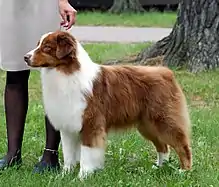 Red Australian Shepherd | |||||||||||||||||||||||||||||||||
| Origin | United States | ||||||||||||||||||||||||||||||||
| |||||||||||||||||||||||||||||||||
| |||||||||||||||||||||||||||||||||
| Dog (domestic dog) | |||||||||||||||||||||||||||||||||
They are similar in appearance to the English Shepherd and Border Collie breeds, and research has found that Australian Shepherds and Border Collies are closely related to each other.[3] This, and the current physical appearance of the Australian Shepherd, tend to support the oral histories, at least in regard that there is some inheritance from landrace farmcollie types of the European mainland.
Australian Shepherds rose in popularity with a boom in Western riding after World War II.[7] They became known to the general public through rodeos, horse shows, and Disney movies made for television.
For many years, Aussies have been valued by stockmen for their versatility and trainability. While they continue to work as stock dogs and compete in herding trials, they have earned recognition in other roles due to their trainability and eagerness to please and are highly regarded for their skills in obedience.[8] Like many working breeds,[9] Aussies have considerable energy and drive. They often excel at dog sports such as dog agility and frisbee and are also highly successful as search and rescue dogs, disaster dogs, detection dogs, guide dogs, service dogs, and therapy dogs. They are considered the 17th-most popular dog breed in the United States.[10]
Physical traits

Size
The Australian Shepherd is traditionally a medium-sized breed. They can weigh from 35 to 70 pounds (16 to 32 kg) and stand from 18 to 23 inches (46 to 58 cm) in height. The Australian Shepherd Club of America (ASCA) standard calls for the Australian shepherd to stand between 18 and 23 inches (46 and 58 cm) at the withers, females being 18 to 22 inches (46 to 56 cm) and males measuring 19 to 23 inches (48 to 58 cm); however, quality is not to be sacrificed in favor of size.[1]
Color
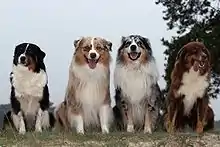
Recognized Aussie colors are solid black, solid red (liver), blue merle, and red/liver merle;[8] each of these colors may also have copper (tan) points or white markings in various combinations on the face, chest, and legs. A black or red dog with copper and white trim is called 'tricolor' or 'tri', while a black or red dog with white trim but no copper is called 'bicolor' or 'bi'. White, rather than pigment, on or around the ears is an indicator of increased risk for white-related deafness. Excessive white on the face and ears can place an individual dog at greater risk for sunburn and subsequent skin cancer.
The wide variety of color combinations comes from the interaction between the color allele, which is either black (B) dominant or red (b) recessive, and the dominant merle allele (M). Together, these provide four coat-color aspects that can appear in any combination:[11]
- Black tri, with copper points, white markings, or both on the face, collar, legs, chest, underbelly - solid black dogs are equally desirable as ones with copper or white.
- Red (liver) with or without copper points or white markings on the face, collar, legs, chest, underbelly - either white or copper points are required. Solid red dogs are equally desirable as ones with copper or white.
- Blue merle (a mottled patchwork of gray and black) with or without copper points or white markings on the face, collar, legs, chest, underbelly - neither white nor copper points are required. Solid Merle dogs are equally desirable as ones with copper or white.
- Red merle (a mottled patchwork of cream and red/liver) with or without copper points or white markings on the face, collar, legs, chest, underbelly - neither white nor copper points are required. Solid Merle dogs are equally desirable as ones with copper or white.[12]
The merle allele, which produces a mingled or patchwork combination of dark and light areas, is the coat pattern most commonly associated with the breed. This merle (M) is dominant, so heterozygous dogs (Mm) show the pigmentation pattern; however, when two merles are bred, the statistical risk is 25% of the offspring will end up with the two copies of the merle gene (homozygous). These dogs usually have a mostly white coat and blue irises and are often deaf, blind, or both. In this case, the deafness and blindness are linked to having two copies of the merle gene, which disrupts pigmentation and produces these health defects.[13] The tri-colored (red, black, and white) Merles will have a 1/4 chance of being blind due to the recessive genes when breeding two Merle colored dogs for the recessive fur color.
All black and blue merle dogs have black noses, eye rims, and lips. All red and red merle dogs have liver or brown noses, eye rims, and lips.
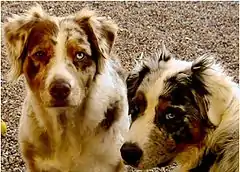
Also, great variety is seen in the Aussie's eye color, and they are often heterochromatic. An early nickname for the breed was "ghost-eye dog". Aussie eyes may be any shade of brown or blue; they may have two different colored eyes, or even have bicolored or "split eyes" (for example, a half-brown, half-blue eye), which appear to be linked to the merle coloration. Merled eyes occur, as well, where one color is mixed in and swirled with another. Any combination of eye color is acceptable in the breed standard, so long as the eyes are healthy. In general, however, black Aussies (self, bi-color, or tri-color) tend to have brown eyes, while red (self, bi-color, or tri-color) Aussies tend to have amber eyes, though these Aussies may also carry the blue-eyed gene.
The merle phenotype in Australian Shepherds is very similar to the coat color in Mitf mouse mutants.[14]
Tail
Although some Aussies are born with naturally bobbed or partially bobbed (stubby) tails, the majority are born with full, long tails. Breeders have historically docked the tails when the puppies are born. In the United States and Canada, the standard calls for a natural bob or docked tail not to exceed four inches as a defining characteristic. Any natural tail length is permitted when showing in Europe, where docking has been banned in most countries, including the United Kingdom.
Temperament

The breed is typically highly energetic, requiring a great deal of exercise and attention.[8][15] An Australian Shepherd enjoys working, whether it is learning and practicing tricks, competing in dog agility, or engaging in any other physically and mentally involving activity.[16]
Dogs may show reserved behaviors. They are kind, loving, and devoted to those they know. They are very loyal to their owners, and are rewarding dogs if treated well.[16] The breed was developed to serve on the ranch,[17] a job which includes being protective of its property. It is not inclined toward obsessive barking.
The Aussie is intelligent, learns quickly, and loves to play.[18] This means that a bored, neglected, unexercised Aussie may invent its own games, activities, and jobs, which to Aussies also do best with plenty of human companionship: they are often called "Velcro dogs" for their strong desire to always be near their owners and for their tendency to form intense, devoted bonds with select people.[16] With children, they work best with children over the age of eight: this is absolutely not because they do not like children or have a short temper with kids (most are quite friendly to children).
The Australian Shepherd has a reputation as a highly intelligent and versatile stock dog with a range of working styles.[19] A good working Aussie is quick, thoughtful, and easy with its stock: there are working lines in the American West that still herd sheep, smaller cattle, and goats. They are fast runners with a loose eye style of working livestock.[20] The ability for the breed to adapt to the situation and to think for itself makes it an excellent all-around worker. For this reason, the Aussie is often chosen to work unusual livestock such as ducks, geese, and commercially raised rabbits.
These dogs require a minimum of one hour a day of play, exercise, and attention. They need space to run and play in an urban setting. The Australian Shepherd is a high-spirited dog that requires much attention and work. Teaching them tricks keeps them focused and happy, which also keeps their minds working. The breed also has great stamina and can live in a variety of terrain. Because of this, they are popularly used as trail and working dogs.[18]
Health
Australian Shepherds are generally a pretty healthy breed, but they can have several health problems. Vision problems are common,[21] and epilepsy is also a concern. In merle-to-merle breeding, the puppies that have inherited two copies of the merle gene have an increased risk of being born blind or deaf.[22]
Mortality
The median lifespans for breeds similar in size to Australian Shepherds are mostly between 11 and 13 years,[23] so, assuming the results of the UK study are not representative of the population there, Aussies appear to have a typical lifespan for a breed their size.
Results of a 1998 internet survey with a sample size of 614 Australian Shepherds indicated a median longevity around 12.5 years, but that longevity may be declining.[23]
Morbidity
Based on a sample of 48 still-living dogs, the most common health concerns noted by owners were eye problems (red eye, epiphora, conjunctivitis, and cataracts).[24] Dermatological and respiratory problems also ranked high.
Collie eye anomaly (CEA) is rare in the breed, but it and cataracts are a concern[25] in Aussies. Other conditions of note include iris coloboma, canine hip dysplasia, Pelger-Huet anomaly, hypothyroidism, and nasal solar dermatitis. Prior to breeding, the Aussie should be checked for hip and elbow dysplasia and DNA tests performed to show the dog to be free of the MDR1 mutation, cataract mutation, and CEA. Tests should also include those for thyroidism and clearances for other known eye diseases like colobomas, progressive retinal atrophy, and retinal folds.
Some Australian Shepherds (as well as Collies, German Shepherds, and many other herding dogs) are susceptible to a genetic mutation of the MDR1 gene.[26] Dogs with the mutation can suffer toxicity from antiparasitics such as ivermectin in high doses, and other drugs.[27] A test is available to determine if a particular dog carries the mutated gene.[28]
Hip dysplasia
Hip dysplasia is a heritable condition where the femur does not fit securely in the pelvic socket of the hip joint. This problem can exist with or without clinical signs, meaning some dogs feel pain in one or both rear legs.[29]
Double merle
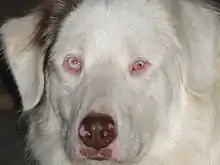
Double merle or homozygous merle occurs when the offspring of two merled parents inherit two copies of the dominant merle gene. The odds of this are 25% for each pup born from such a litter.[13] Double merles often have excessive light or white areas and can have hearing and vision problems as a result of having two copies of the merle gene.[15] Homozygous merles can be deaf or blind, or express iris colobomas, retinal detachment, cataracts, persistent pupillary membrane, a displacement of the lens, equatorial staphyloma, night blindness and microphthalmia. Audio impairment or deafness usually develops after the birth of a puppy with their ear canal still closed. The white color of double merles is produced due to the lack of melanocytes which provide high potassium levels in the endolymph surrounding the cochlea's hair cells. There is no surgery or treatment that can reduce the damage. Loss of hearing is directly linked to the amount of pigmentation cells a dog has. The same pigment that is lacking in the ear can also be lacking in the eyes, affecting its development. Although many believe that only dogs with blue eyes have eye problems, it is not correct. Due to the contrast between eye problems and blue eyes, eye conditions in blue-eyed dogs are much easier to spot.[15]
Not all homozygous merles are affected, but most are, making the breeding of two merles a very touchy subject. Some breeders euthanize mostly white pups, while others may attempt to sell them as "rare" white Aussies without disclosing the potential for health defects.[30] A large percentage of homozygous merles sold eventually end up in rescue and shelters, as the average family is ill-prepared to take on a deaf or blind pet. However, deaf or blind Australian shepherds can make wonderful pets given a home prepared for their special needs. They are an intelligent breed, which generally learn hand signals with ease.
The term "lethal white" originated from horses born with lethal white syndrome, and has since evolved to often describe dogs born with the double merle trait. This trait is found in many breeds, but most commonly found in Australian Shepherds. The name "lethal white" is a misnomer, as this genetic condition is not lethal to the dogs; it is often the breeder who is lethal to the pups by culling them immediately after birth.[31][15] Many consider the term "lethal white" to be derogatory.[32]
Available health tests
Many diagnostic tests are available for concerned Aussie owners to check the overall health of a dog. Also, the Orthopedic Foundation for Animals (OFA) has an extensive database to track results and provide statistics for these concerns: hips, elbows, heart, patellar luxation (knees), and thyroid (autoimmune) disease. The OFA database also includes the results for eye exams performed by a Canine Eye Registration Foundation veterinarian, but only if the owner of the Aussie submits the results. This database is a great resource to investigate the lineage and related health of the progenitors of some dogs, at least regarding hip ratings.
Many tests have been developed by, or are processed at, laboratories to check for the 11 health concerns that plague the Australian Shepherd breed. Some of those labs are Optigen, Animal Health Trust, Endocrine Diagnostic Center, Animal Health Laboratory, Washington State University Veterinary Clinic, Vet DNA Center, and HealthGene. These labs might perform one or many of the tests that have been developed.
Tests or evaluations have been developed for:
- Hip and elbow dysplasia
- Patellar luxation (knees)
- Eyes
- Collie eye anomaly
- Progressive retinal atrophy
- Thyroid (autoimmune) – multiple labs perform this test-check OFA application for list
- Congenital Cardiac (heart)
- Multidrug resistance gene
- Hereditary cataracts
- Pelger-Huet anomaly
- Epilepsy
Other areas that are currently not health concerns, but tests have been developed for, are:
- Coat color (red carrier/red factored) – Vet DNA Center and HealthGene process this sample
- Dilute gene carrier – Vet DNA Center and HealthGene process this sample
DNA testing to either certify parentage or to verify parentage) for Australian Shepherds can be performed, and as of January 2010, all adults producing a litter will be required to be DNA tested to allow a breeder to register a litter with the Australian Shepherd Club of America (ASCA).
History
.jpg.webp)
The Australian Shepherd's history is vague, as is the reason for its misleading name. The breed was initially called by many names, including Spanish Shepherd, Pastor Dog, Bob-Tail, New Mexican Shepherd, California Shepherd, and Austrian Shepherd. It is believed by some that the breed has Basque origins in Spain and was used there by shepherds.[8] Those shepherds might then have emigrated to the West Coast of the United States via Australia.[33][34][17] What is known is that it developed in western North America in the 19th and early 20th centuries. The Australian Shepherd was a particularly tireless sheep herder in the Rocky Mountains because it is relatively unaffected by altitude. Ranchers in Boulder, Colorado, began breeding the dogs which would attract purchasers from as far west as California for their legendary sheep-herding abilities. A theory suggests that they were named for the imported sheep that they herded. It is also possible that many of the dogs coming from Australia were blue merle and the adjective "Australian" became associated with any dogs of that coat color.[11]
Recent history
Development of the breed began in the American West. The breed's foundation bloodlines are depicted in the Australian Shepherd Genealogy Chart showing the relationship between the early families of dogs.[35] The American Kennel Club (AKC) ranked the Australian Shepherd as the 17th-most popular breed in the United States in 2016.[36]
Selective breeding for many generations focused on aspects of the dog that enabled it to function as an effective stockdog in the American West. It had to handle severe weather; have plenty of speed, athleticism, energy, and endurance; and be intelligent, flexible, and independent; while remaining obedient. The actual foundation for the Australian Shepherd was established between the 1940s and the early 1970s, when the Australian Shepherd Club of America was formed and the registry was started.[37]
Their stunts and skills earned them places in several Disney films, including Run Appaloosa Run and Stub: The Greatest Cowdog in the West.[11][38] An Australian shepherd was featured in the film Flight of the Navigator (1986) and the TV series Flash Forward (1996). More recently, an Australian Shepherd starred in the film Famous Five (2012) and its sequels.
In June 2017, U.S. Vice President Mike Pence and his family adopted a Blue Merle Australian Shepherd named Harley.[39]
Club recognition
The Australian Shepherd Club of America (ASCA) was founded in 1957 to promote the breed. The National Stock Dog Registry became its official breed registry, which continued until ASCA took over in 1972.[40]
In 1975, ASCA created a breed standard, describing exactly how an Australian shepherd should look and be constructed (its conformation to the Standard). It developed more uniformity in the breed and standardized the type.
In the United States, the American Kennel Club (AKC) is the primary registry for purebred dogs, and first recognized the Australian Shepherd in 1993 as a member of the Herding group.[8] However, many Aussie breeders felt the AKC put too much emphasis on breed conformity and not enough on performance, so the ASCA declined to join the AKC. Those breeders who felt that AKC membership had its advantages split off from ASCA to form their own Australian Shepherd club, the United States Australian Shepherd Association, created their own breed standard, and joined the AKC in 1993. The decision about affiliation with the AKC remains controversial, as it does with many performance breeds.
The Fédération Cynologique Internationale (FCI-World Canine Organization) recognized the Australian Shepherd for international competition in 2007, in Group 1 Sheepdogs and Cattle Dogs as breed number 342.
The Miniature Australian Shepherd was developed by breeders looking for smaller dogs ranging in size from 14 inches to the Aussie standard. In 2010, NAMASCUSA renamed the breed Miniature American Shepherds and subsequently changed their name to MASCUSA, The Miniature American Shepherd Club of the USA. This new breed gained acceptance into the AKC Miscellaneous class in June 2012 with the sizes written in the standard as females from 13 to 17 inches and males from 14 to 18 inches.
In addition, an emergence of an even smaller version occurred, referred to as the Toy Australian Shepherd, with adult males weighing 12–15 pounds (5.5–7 kg) and all dogs falling under a 14-inch height at the withers. Many breeders and owners of Australian Shepherds consider the Mini and Toy to be separate breeds; others consider them to be downsized versions of the same breed. While the Mini size can be attained through selective breeding of small Australian Shepherds, the Toy size is typically a result of cross breeding with other toy breeds. ASCA and AKC consider both variants to be separate breeds.[1]
Activities
Like other herding breeds, these dogs excel at many dog sports, especially herding, dog agility, frisbee, and flyball.[8] Herding instincts and trainability can be measured at noncompetitive instinct tests. Aussies that exhibit basic herding instincts can be trained to compete in ASCA stock dog trials or AKC herding events.[8][41]
The dog has a stride in which its front and back legs cross over, making for an appearance of "on the edge" speed. The dogs instinctively use a "pounce" position to deal with cattle trying to kick them. They also have strong hips and legs, allowing for fast acceleration and high jumping, sometimes as high as 4 ft (1.3 m).
An Australian shepherd named Pockets is credited as being the oldest dog to earn a title in AKC history, having earned the Rally Novice title at the age of 15 years, 5 weeks.[42]
 A blue merle in a dog agility competition
A blue merle in a dog agility competition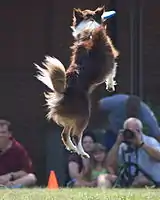 Australian Shepherd catching a frisbee
Australian Shepherd catching a frisbee
References
- "Australian Shepherd Breed Standard". Australian Shepherd Club of America, Inc. January 15, 1977. Retrieved April 3, 2011.
- "The History of Australian Shepherds Chapter II: Timeline: Breed Development From Obscurity Into Mainstream Popularity". November 2008. Retrieved April 3, 2011.
- https://www.cell.com/cell-reports/pdf/S2211-1247(17)30456-4.pdf
- "About Aussies. Australian Shepherd Association". Archived from the original on 2007-09-19.
- "Vanished Trials and Faded Memories of Australian Shepherd History". American Kennel Club. 2007. Retrieved April 3, 2011.
- Josh Dean. "The Australian Shepherd is from: A) Australia, B) England, C) Spain, D) None of the Above". Archived from the original on 2012-02-05.
- "American Cowboy". Active Interest Media, Inc. Jan–Feb 1997. Cite magazine requires
|magazine=(help) - "Get to Know the Australian Shepherd", 'The American Kennel Club', retrieved 19 May 2014
- While many working breeds are notable for their drive, which manifests as a need to be active, or "to DO", there are some who do not have this trait. Notably livestock guardian dogs may fall in this category, but also some dogs with droving inheritence. The Great Pyrenees breed is a good example of a dog who does not (generally) exhibit the need to be constantly active. Some droving/butcher's dogs breeds are also less driven, even though they are active, e.g. Rottweilers.
- "Australian Shepherds".
- Coile, D. Caroline (1999). "History of the Australian Shepherd". Australian Shepherds. Barron's. pp. 5–7.
- "Basic Body Colors of the Australian Shepherd". Australian Shepherd Club of America, Inc. Retrieved April 3, 2011.
- "White-linked Deafness in Australian Shepherds". Australian Shepherd Club of America, Inc. 1998. Retrieved April 3, 2011.
- Hedan, Benoit (January 2006). "Coat Colour in Dogs: Identification of the Merle Locus in the Australian Shepherd Breed". BMC Veterinary Research. 2: 9. doi:10.1186/1746-6148-2-9. PMC 1431520. PMID 16504149.
- Mark., Manfield (2017-05-13). Australian Shepherd Bible and the Australian Shepherd : Your Perfect Australian Shepherd Guide Covers Australian Shepherds, Australian Shepherd Puppies, Australian Shepherd Training, Mini Australian Shepherds, Australian Shepherd Breeders, Size, Health, More!. Milano. ISBN 9781911355564. OCLC 1005140424.
- "Is the Australian Shepherd Right for you?". Australian Shepherd Club of America, Inc. Retrieved April 3, 2011.
- The dog encyclopedia. Dennis-Bryan, Kim. Baggaley, Ann. John, Katie. (First American ed.). New York: DK Publishing, Inc. October 2013. p. 68. ISBN 9781465421166. OCLC 859155647.CS1 maint: others (link)
- "Aussie Personality & Character". Australian Shepherd Club of America, Inc. 1998. Retrieved April 3, 2011.
- "Working Description". Australian Shepherd Club of America, Inc. Retrieved April 3, 2011.
- "Working Aussie Source FAQs – Working Aussie Source". www.workingaussiesource.com. Retrieved 2018-04-28.
- "Hereditary Defects of the Australian Shepherd". Australian Shepherd Club of America, Inc. Retrieved April 3, 2011.
- "Canine Epilepsy". Australian Shepherd Club of America, Inc. 1999. Retrieved April 3, 2011.
- "The Goody Pet". Retrieved 2019-02-28.
- Kennel Club/British Small Animal Veterinary Association Scientific Committee. 2004. Purebred Dog Health Survey. Retrieved July 5, 2007
- "Collie Eye Anomaly (CEA)". Australian Shepherd Club of America, Inc. Retrieved April 3, 2011.
- "MDR1 FAQs". Australian Shepherd Health & Genetics Institute, Inc. Archived from the original on December 13, 2007. Retrieved April 3, 2011.
- "Problem Drugs". Washington State University College of Veterinary Medicine. December 8, 2010. Archived from the original on 14 May 2011. Retrieved April 3, 2011.
- "Get Your Dog Tested". Washington State University College of Veterinary Medicine. January 19, 2011. Archived from the original on 29 April 2011. Retrieved April 3, 2011.
- "Hip Dysplasia in Dogs: Diagnosis, Treatment, and Prevention". www.peteducation.com. Retrieved 2016-05-12.
- "What's Wrong With White Aussies?". Retrieved 24 April 2014.
- "Homozygous "Lethal White" Merles". Retrieved 13 January 2013.
- "What is a double merle?" (PDF). Retrieved 13 January 2013.
- "The History of Australian Shepherds Chapter III: Vanished Trails and Faded Memories of Australian Shepherd History (Aussie History Revisited)". Las Rocosa Australian Shepherds. 2010. Retrieved April 3, 2011.
- "ASCA Working Description of Aussies". Official Breed Club Site.
- "The Spider Web (Australian Shepherd Genealogy Chart)". Las Rocosa Australian Shepherds bob. Retrieved April 3, 2011.
- , The American Kennel Club, retrieved 30 April 2016
- Hartnagle, Carol Ann, Ernest (2006). The Total Australian Shepherd:Beyond the Beginning. Hoflin Publishing. ISBN 978-0-86667-072-2.
- Hartnagle, Joseph (1990). Australian Shepherds. T.F.H.
- Bennett, Kate (June 19, 2017). "Mike Pence gets a puppy". CNN Politics. Retrieved February 16, 2018.
- "The History of The Australian Shepherd Club of America". Las Rocosa Australian Shepherds. Retrieved April 3, 2011.
- Hartnagle-Taylor, Jeanne Joy; Taylor, Ty (2010). Stockdog Savvy. Alpine Publications. ISBN 978-1-57779-106-5.
- Thompson, Sally (November 10, 2005). "Plymouth dog sets American Kennel Club record". Minnesota Local News. Sun Newspapers. Archived from the original on April 20, 2012. Retrieved April 3, 2011.
Further reading
- Hartnagle, Carol Ann; Hartnagle, Ernest (2006). Total Australian Shepherd: Beyond the Beginning. Hoflin Publishing. ISBN 978-0-86667-072-2.
- Hartnagle-Taylor, Jeanne Joy (2005). All About Aussies. Alpine Publishing. ISBN 978-1-57779-074-7.
- Hartnagle-Taylor, Jeanne Joy; Taylor, Ty (2010). Stockdog Savvy. Alpine Publications. ISBN 978-1-57779-106-5.
- Cunliffe, Juliette (2004). The Encyclopedia of Dog Breeds. Parragon Publishing.
- Fogle, Bruce (2000). The New Encyclopedia of the Dog. Dorling Kindersley (DK).
- Renna, Christine Hartnagle (2000). Herding Dogs: Selection and Training the Working Farm Dog. Kennel Club Books. ISBN 978-1-59378-737-0.
External links
| Wikimedia Commons has media related to Australian Shepherd. |
- Australian Shepherd at Curlie – An active listing of Australian Shepherd links.